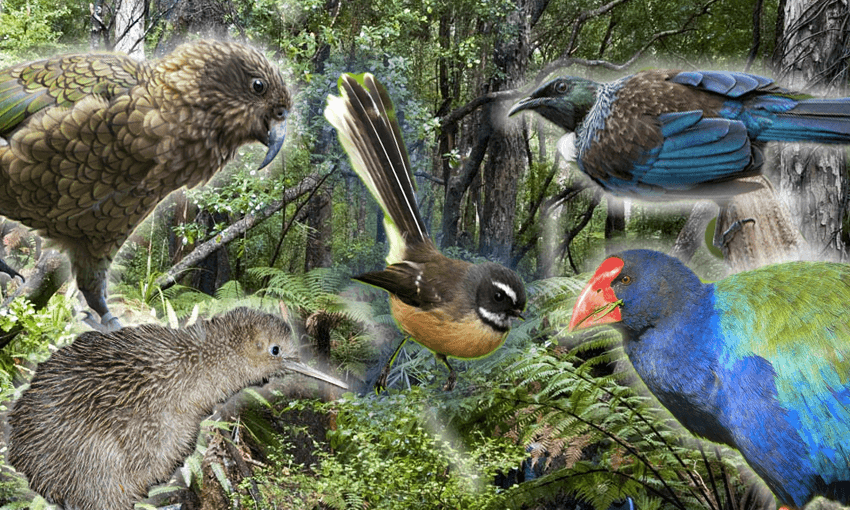The birds of Polynesian legend are part of birth, death, and everything in between. Now, a PhD thesis from the University of Otago undertakes the first ever in-depth exploration into the manu of mythology.
From the flittering pīwakawaka that woke Hine-nui-te-pō and caused the death of Maui, to the Tahitian doves bringing figs to earth, manu play an important part in the oral histories of many Polynesian cultures. Birds have nourished, fought, betrayed and befriended the heroes and heroines of folklore for hundreds of years. Now the roles they played in these stories have been collected in Manu narratives of Polynesia, Raphael Richter-Gravier’s doctoral thesis for the University of Otago.
Born in France, Richter-Gravier’s passion for Polynesia was born almost two decades ago when he moved to New Zealand and became interested in te reo Māori. “When you grow up in New Zealand you hear te reo Māori from a very young age and it sounds familiar, but when you’ve come from France and you’ve never heard a word of Māori it’s really striking because it’s so different. It’s not like European languages.” Richter-Gravier followed this passion through four years of studying the language and the culture. But it was a personal connection with his own pet bird, a musk lorikeet named Kowhai, that helped him decide on the subject of his PhD.
“When I approached [my supervisor] about a possible topic for a PhD, he told me to read books about Māori culture to get some possible ideas.When I came across birds in one of those books I thought it could be a topic. I have a pet bird and I like her very much [but] I had never thought about the importance of birds in traditional Māori culture.”
Richter-Gravier says his study of reo and tikanga Māori played a huge part in understanding many of the stories in his thesis. But it wasn’t just his grasp on this one language that helped in the research. He can speak Spanish, French and English; his high school level German and university reo Māori were also crucial. “If you have a Māori text and you don’t know the reo then you won’t be able to identify the key Māori words you’re looking for in the stories. I was lucky enough to have a supervisor at the University of French Polynesia in Tahiti, and he was fluent in Tahitian… It also helped to know a bit of German because in Samoa – in particular [with publications from] the 19th and beginning of the 20th centuries – a lot of those Samoan stories are only in German or Samoan, but not in English.”
This grasp of languages also helped Richter-Gravier uncover little-known texts. His supervisor Professor Michael Reilly, the coordinator of the Pacific Islands Studies programme at the University of Otago, says this not only helped Richter-Gravier understand the texts themselves, but also the world views of the Polynesian cultures where they originated. “He was able to get stories that had been collected in an original language and published in some hard-to-find monograph, but hadn’t been used by anyone else because you had to understand that language.”
Once 300 stories were collected, Richter-Gravier set about categorising them into seven groups: Genesis, Aetiology, Vehicle, Communication, Custody, Eros and Thanatos. He was surprised by the links he found in stories between the various Polynesian countries. “A lot of Polynesian islands share a great number of stories, because people used to travel between the islands. I found that surprising, because when I first started my research I had thought that each island was very isolated from the others, because the Pacific is so huge.”
Reilly said this link could be useful for more than just Pacific historians. “Perhaps there are connections of varying kinds that we’re not fully aware of because it may not be clear to archaeologists or biological anthropologists with just their DNA reconstructions … I can imagine they might find the same or similar stories coming from different places that could be quite suggestive of patterns and connections.”
The future of the study includes a collaborative art exhibition with Dunedin-based woodcut artist Manu Berry. Berry’s made over 50 wood cuts of the birds in Richter-Gravier’s study, and they will be exhibited at the Pea Sea art gallery in Port Chalmers throughout February. “I didn’t want my thesis to be just text,” says Richter-Gravier. “I thought I would have to pay but [Berry] actually did it for free because he was interested in the topic and the stories … I wasn’t expecting it.”
Richter-Gravier has found his study is connecting with an audience beyond academia. Although there are no plans yet, he’s interested in looking into his research could be published. “Would it be a coffee table book with lots of illustrations, or would it be a more scholarly book for academics, more like what my thesis is like at the moment? Would it be for children? I would have to make the stories more accessible, but some of them could be made accessible to children with illustrations. What I like about it is that it can appeal to lots of different people – those who are interested in Māori culture, people who are interested in birds, people who are interested in stories.”
While the thesis acts as a catalogue of 300 manu of Polynesian legend, Reilly says it’s much more than that. “In a way, Raphael was trying to pay homage to all these storytellers, many of whom are unknown to us, and how they tell these wonderful stories about birds in their society.
“It’s really how human beings understood birds in the Pacific – birds as messengers, birds as gods, birds as part of the environment.”
This content was created in paid partnership with the University of Otago. Learn more about our partnerships here.

